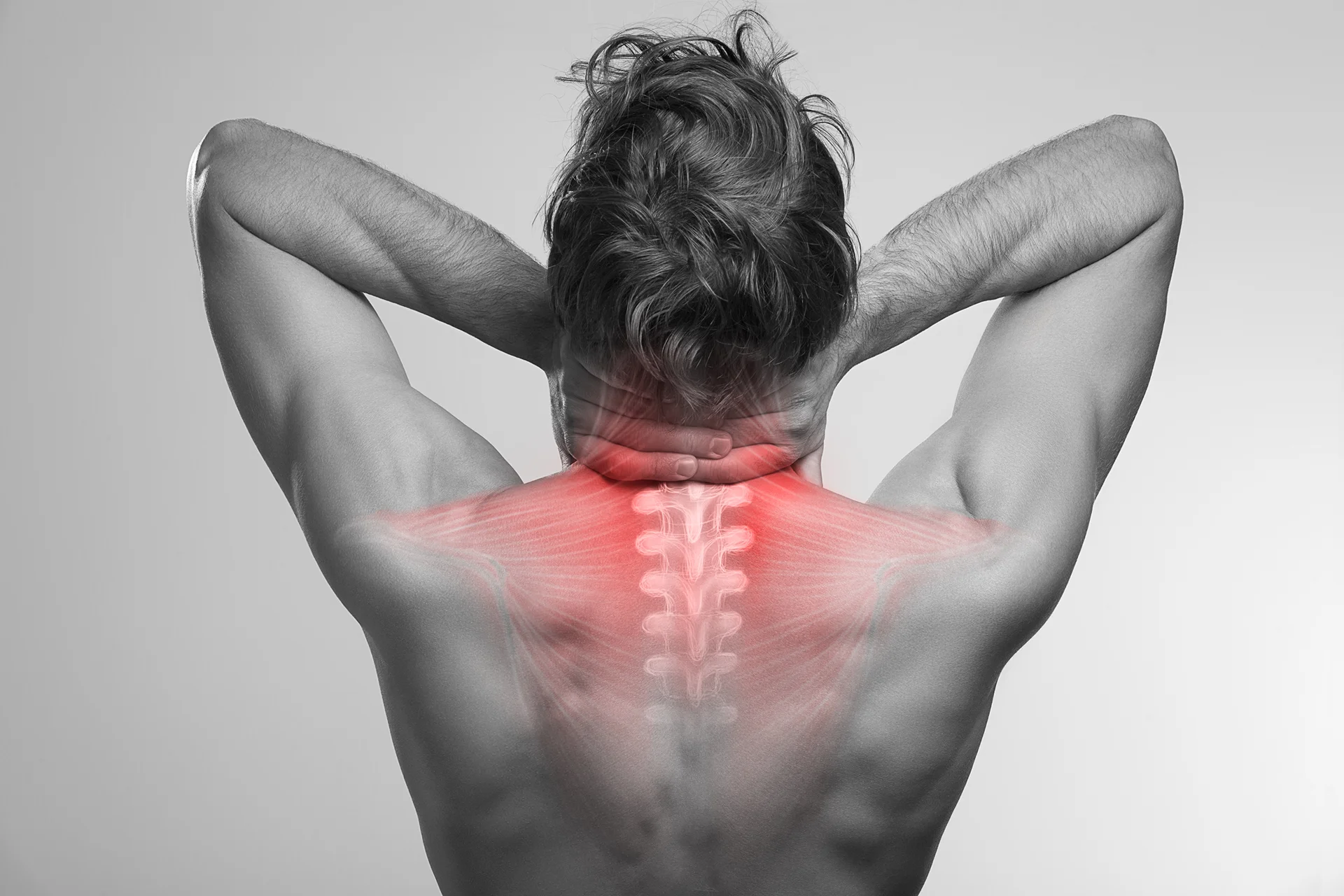Does it feel like there’s a tennis ball lodged between your shoulder blades? Do you wince when reaching for your seatbelt or rolling over in bed? Plenty of us aren’t strangers to these unwelcome sensations.
Millions of Americans deal with discomfort in their upper back each year. And while the causes vary, loosening tight muscles and strengthening weak ones have proven to work, besides other solutions.
Want to take a shot at finally releasing that nagging tension? Let’s dig into the best stretches and exercises to ease upper back pain and help you move comfortably again.
So What’s Really Causing That Annoying Upper Back Pain?
Before we dive into solutions, let’s look at why your upper back (also known as your thoracic spine) may be provoking pain in the first place. Have you ever wondered what’s behind that stubborn sensation you just can’t seem to shake?
Here are some of the most common culprits:
Poor Posture
Slouching or hunching over can strain muscles between your neck and shoulders. Activities like looking down at phones and laptops for long periods promote poor posture.
Osteoporosis and Compression Fractures
Loss of bone density from osteoporosis can lead to painful compression fractures in the vertebrae. Over time, osteoporosis causes the bones to become porous and weakened, increasing the risk of fractures.
Compression fractures in the thoracic spine can cause pain and limited mobility. They are especially common in older adults due to weakened bone density.
Myofascial Pain Syndrome
This chronic pain condition can cause pain and tightness in the muscles of the upper back. It is caused by trigger points or knots that develop in the fascia and surrounding connective tissues.
Myofascial pain often occurs along with poor posture, muscle overuse, or injury.
Spinal Deformities
Conditions like scoliosis and Scheuermann’s kyphosis can cause strain on the spine and lead to upper back pain6.
Scoliosis involves an abnormal sideways spinal curve while kyphosis leads to excessive rounding of the upper back. Both put added pressure on surrounding muscles, ligaments, and discs.
Infections
In rare cases, infections like spinal epidural abscess can cause upper back pain6. Infection of the epidural space around the spinal cord leads to inflammation and compression of nerve roots exiting the spine.
Upper back pain can result when nerves in the thoracic area are impacted.
Muscle Strain
Overuse and repetitive movements like reaching overhead can cause muscle tightness or spasms. Weightlifting with improper form is another common cause.
Injuries
Sports injuries, car accidents, or falls can injure structures like discs and joints leading to inflammation and pain.
Arthritis
Degenerative types of arthritis like osteoarthritis can affect the joints along the upper spine. This causes bone spurs and narrowed disc space.
Lung Cancer
In very rare cases, lung cancer can cause upper back pain. Advanced lung tumors can grow large enough to press against nerve roots or vertebrae in the upper back and lead to pain. To be clear, this is an atypical early symptom of lung cancer.
While pinpointing the exact cause of your upper back pain requires an exam by your doctor, stretching and exercises are safe and effective in most cases. Let’s look at how they help banish pain.
How Stretches And Exercises Relieve Upper Back Pain

When you’re dealing with discomfort, moving more might seem counterintuitive. But stretching and exercising offer many benefits for upper back pain including:
- Improved Flexibility – Stretches lengthen tight muscles and increase range of motion of the thoracic spine, shoulders, and neck. This alleviates muscle tension, stiffness, and pain.
- Strengthening – Exercises reinforce weak muscles that contribute to poor posture like the rhomboids between your shoulder blades. Stronger muscles better support your upper back.
- Increased Circulation – Movement boosts blood flow to deliver nourishing oxygen and nutrients to muscles and spinal tissues. This aids healing.
- Posture Correction – Targeted exercises retrain proper alignment. This reduces strain on muscles, joints, and discs.
- Relief of Muscle Spasms – Gentle stretching releases knotted muscles and painful spasms throughout the upper back.
- Long-Term Pain Management – A regular program of stretching and exercises helps manage chronic upper back pain.
While a few sessions of stretching can offer quick relief, the key is consistency. Regularly practicing these movements lengthens muscles long-term and keeps pain from recurring.
Read on to learn some of the best physical activities to include in your upper back pain relief routine.
Key Muscles And Areas To Target
Before we get to the workouts, it helps to familiarize yourself with the main muscles that span your upper back:
| Muscle | Role and Impact on Upper Back Pain |
| Trapezius | This large, triangular muscle extends from the base of your skull, out to your shoulder tips, and down to your mid-back. Tightness here is a major cause of neck, shoulder, and upper back pain. |
| Rhomboids | These connect your shoulder blades to your thoracic spine. Weak rhomboids cause the shoulders to slump forward. |
| Levator Scapulae | This runs down the sides of the neck and attaches the collarbone to the cervical spine. Tightness here can cause neck pain and stiffness. |
In addition to these muscles, be sure to stretch and strengthen the thoracic spine itself through its full range of motion. The shoulders, chest, and neck are also important to address as they interconnect and influence the upper back.
With those key areas in mind, let’s explore some of the top stretches and exercises to beat upper back pain.
Upper Back Stretches Worth Doing
When it comes to stretching, slow and gentle movements are the name of the game. Here are six soothing stretches to try:
1. Corner Stretch
– Stand facing a corner, feet shoulder-width apart.
– Place your forearms against the walls forming a 90-degree angle. Elbows should be slightly below your shoulders.
– Keeping your shoulders down, gently lean your chest forward to feel a stretch across your chest and front shoulders.
– Hold for 20-30 seconds. Repeat 2-3 times.
2. Doorway Stretch
– Stand in a doorway facing the door frame.
– Raise your arms to shoulder height and bend elbows 90 degrees.
– Place forearms against the doorframe with wrists straight.
– Shift your upper body forward until you feel a deep stretch across your chest and front shoulders.
– Hold for 20-30 seconds. Repeat 2-3 times.
3. Arm Crosses
– Sit or stand with a good upright posture.
– Bring your right arm straight out to your side, parallel to the ground.
– Pull the right arm across your chest with your left hand on your right elbow.
– Feel the stretch in your right shoulder and upper back.
– Hold for 20 seconds. Repeat on the opposite side. Do 2-3 reps per side.
4. Chin Tucks
– Sit or stand with proper upright posture.
– Look straight ahead and tuck your chin in slightly towards your chest.
– You should feel the stretch in the back of your neck and across your upper back.
– Hold for 10 seconds. Repeat 5 times.
5. Side Neck Stretch
– Sit or stand upright with shoulders back.
– Slowly bend your head to the right, bringing your right ear towards your right shoulder.
– Place your right hand on your head for added stretch, but do not force the movement.
– Hold for 20 seconds. Repeat on the left side. Do 2-3 reps per side.
6. Upper Back Rotation
– Sit on a chair with knees bent and feet flat. Keep your chin tucked slightly and chest lifted.
– Place your right hand on your left knee, then twist your upper body to the left.
– Hold for 10-15 seconds. Repeat on the opposite side. Do 5 reps per side.
Move carefully through these upper back stretches, only going to your point of mild tension. Pain during stretching can indicate injury. Deep breathing enhances the benefits.
Targeted Exercises For Upper Back Strength
Stretches alone are not enough—strengthening key muscles is crucial for lasting relief. Try these effective exercises:
1. Seated Row
- Sit on the floor with legs extended and knees soft. Hold a resistance band in front of you with both hands.
- Keeping back straight, pull the band back squeezing shoulder blades together.
- Slowly return to the start position.
- Repeat 10-15 times. Do 2 sets.
Additional sets are beneficial for building more strength. You can also try a variation of 3-4 sets of 8-12 reps.
2. Band Pull Aparts
- Stand holding a resistance band extended in front of you.
- Pull hands apart against the tension of the band squeezing shoulder blades.
- Slowly return hands to the start position.
- Repeat 10-15 times. Complete 2-3 sets.
For optimal strength gains, you can aim for higher rep ranges like 15-20 reps for 3-4 sets.
3. Prone Y Raises
- Lie face down on a mat with arms extended overhead forming a Y shape.
- Keeping arms straight, raise them a few inches off the floor. Pause.
- Slowly lower back down.
- Repeat 8-10 times. Do 2 sets.
4. Dumbbell Shoulder Presses
- Stand holding dumbbells at shoulder height with palms facing forward.
- Press dumbbells directly overhead, then slowly lower back to shoulders.
- Repeat 10 times. Complete 2-3 sets.
5. Rear Delt Fly
- Holding dumbbells, bend at hips until the torso is parallel to the floor.
- With arms extended straight, raise arms out to sides until parallel with the ground.
- Slowly lower back to start. Repeat 10 times, 2-3 sets.
6. Reverse Pec Deck Machine
- Sit on the machine with your back flat against the pad.
- Grasp handles and bring arms back squeezing shoulder blades.
- Slowly return to the start position. Repeat 10-12 reps, 2 sets.
Including a rear delt fly with dumbbells and a reverse pec deck machine exercise would target the posterior deltoids. This would complement the other exercises working the front and middle delts for balanced development
Remember to execute all of these moves slowly and with control. Start with light resistance and build up gradually. Proper form prevents injury. Don’t forget to warm up!
Integrate Regular Workouts For Ongoing Relief
Now that you’re familiar with the ideal training exercises, how do you put them to work long-term? Follow these tips for a sustainable routine:
- Dedicate 10 minutes twice a day. Consistency is vital.
- Warm up with a gentle range of motion before and stretch afterward.
- Focus on good posture in sitting and standing throughout your day.
- Stay active with cardiovascular exercise to nourish spinal tissues.
- Pay attention to ergonomics like your pillow, workstation, and driving position.
- Know when to seek extra help from a physical therapist or doctor.
- Keep up your program even after the pain subsides to prevent recurrence.
While back pain can be frustrating, simple workouts offer an accessible way to find relief. Loosen tension, strengthen your upper back, and renew your freedom to move comfortably. Don’t live with discomfort—try these tips to feel your best.
Treat the Root Cause – Call for Expert Help to Beat Upper Back Pain
Investing just a few minutes a day to better support your upper back pays off in the long run with improved mobility, fewer headaches, and renewed energy.
If simple stretches aren’t providing lasting relief or your pain worsens, it may be time to rely on professional help.
At Kaly, we make it easy to connect with certified specialists who create customized treatment plans to address your unique pain triggers.
Just answer a few quick questions and our advanced matching system will pair you with the right providers to meet your needs, preferences, and coverage.
